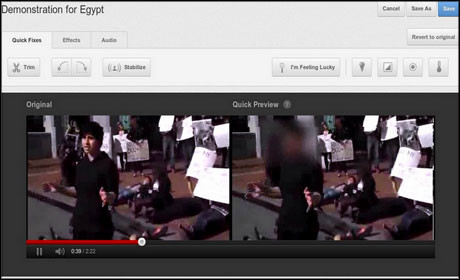
Image taken form the YouTube blog
YouTube has announced the launch of face blurring, allowing citizen journalists or anyone who wants to protect the anonymity of children to obscure faces.
The video-sharing website's blog states that "as citizens continue to play a critical role in supplying news and human rights footage from around the world, YouTube is committed to creating even better tools to help them".
YouTube's new feature enables users to "blur all faces", but warns that "it’s possible that certain faces or frames will not be blurred".
But could face blurring make the task of verification that journalists a frequently tasked with carrying out more difficult?
Markham Nolan, managing editor of Storyful, a social media news agency, said he does not see any negative implications and welcomed the option of allowing sources to conceal a person's identity for security reasons.
"Seeing an individual's face doesn't help us that much with the verification process," Nolan told Journalism.co.uk.
He said that faces can help with understanding emotion but that the rest of the process, such as checking where shadows fall to investigate whether the time of day a video or picture was claimed to have been taken corresponds, does not require non-obscured faces.
According to the YouTube blog, "blurring faces on YouTube is simple".
"This is emerging technology, which means it sometimes has difficulty detecting faces depending on the angle, lighting, obstructions and video quality. It’s possible that certain faces or frames will not be blurred. If you are not satisfied with the accuracy of the blurring as you see it in the preview, you may wish to keep your video private."
Update: Markham Nolan has also blogged about what YouTube new feature could mean in terms of verification. See 'blurring faces makes security a key priority'.
Free daily newsletter
If you like our news and feature articles, you can sign up to receive our free daily (Mon-Fri) email newsletter (mobile friendly).









